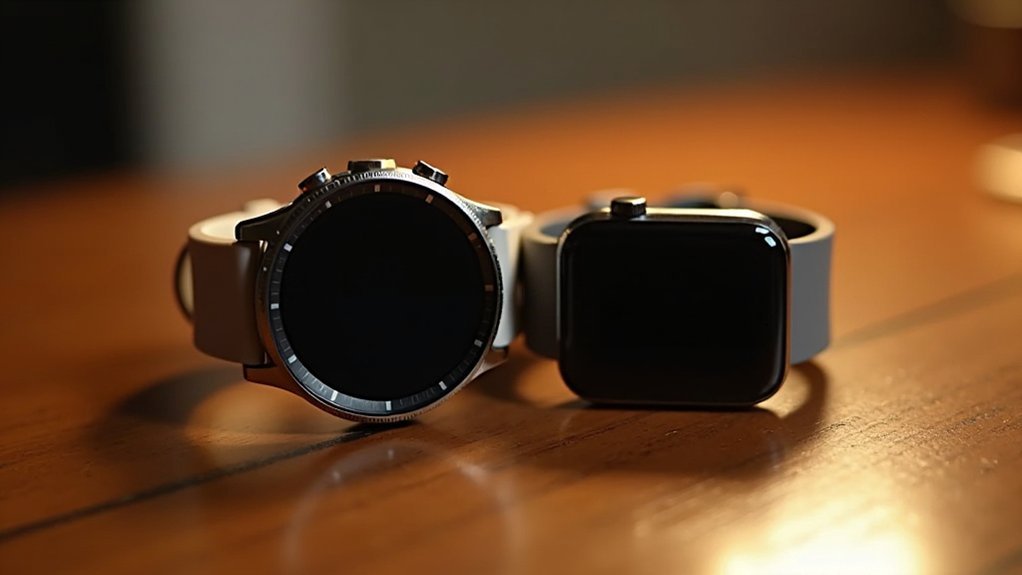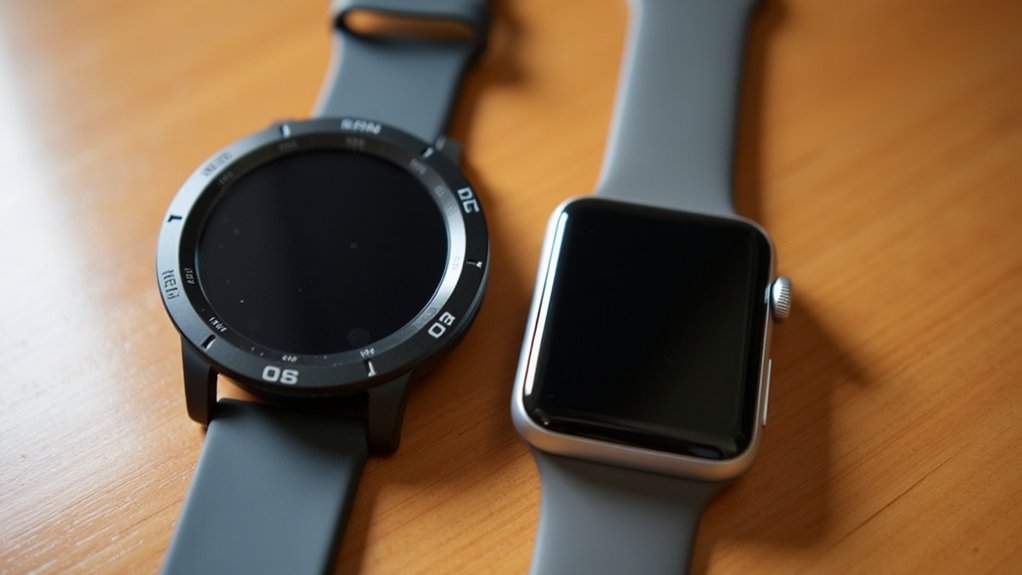When choosing between Garmin and Apple watches in 2025, you’ll find three major OS differences that’ll shape your experience. Garmin prioritizes cross-platform compatibility while Apple focuses on seamless iOS ecosystem integration. Battery management differs drastically – Garmin’s MIP displays deliver up to two weeks of use versus Apple’s daily charging requirement. Interface design also contrasts sharply, with Garmin combining physical buttons and touchscreens for outdoor reliability while Apple emphasizes premium touch-based interactions. Understanding these distinctions helps determine which platform aligns with your lifestyle priorities.
App Ecosystem and Third-Party Integration Capabilities

One of the most significant differences between Garmin and Apple Watch lies in their approach to app ecosystems and third-party integration.
Apple Watch offers seamless integration with the Apple ecosystem, giving you direct access to the App Store and native apps like Messages and Mail. You’ll find extensive third-party support, Apple Pay for transactions, and HomeKit compatibility for smart home control.
Garmin takes a different approach, prioritizing cross-platform compatibility with both iOS and Android devices. You’ll get specialized fitness apps with features like VO2 max tracking and heart rate zones, plus integration with health services like Wellness. Garmin devices are engineered for deep performance tracking, providing serious athletes with comprehensive training metrics.
While Garmin’s app selection isn’t as extensive, it provides versatile data sharing across platforms.
Battery Performance and Power Management Systems
While both smartwatches serve fitness enthusiasts, their battery performance reveals markedly different philosophies.
You’ll get up to 2 weeks from Garmin’s Forerunner 55 in smartwatch mode, while Apple Watch requires daily charging with its 18-hour typical usage. Garmin’s memory-in-pixel displays consume considerably less power than Apple’s vibrant AMOLED screens, creating a clear trade-off between visual quality and endurance. The titanium construction of premium models like the Apple Watch Series 10 provides exceptional durability without compromising the sleek design that users expect.
- Garmin offers solar charging on select models for extended outdoor adventures
- Apple Watch Ultra provides improved battery life but still can’t match Garmin’s duration
- Garmin’s GPS mode delivers 20 hours of continuous tracking for long activities
- Apple focuses on integrating smart features while sacrificing battery longevity
- Both brands use different power management strategies reflecting their target users’ priorities
User Interface Design and Environmental Durability Features

The fundamental divide between Garmin and Apple extends beyond battery life into how you’ll interact with your smartwatch and whether it can withstand your adventures.
Garmin’s dual approach combines five physical buttons with touchscreen controls, giving you reliable input during activities when touchscreens fail. Their MIP displays and solar charging prioritize outdoor visibility and multi-day expeditions, while MIL-STD-810 certification guarantees survival in harsh conditions. Garmin continues to enhance their solar efficiency technology across their product lineup, building on the success of models like the Instinct series.
Apple emphasizes a fully touch-based interface with fluid animations and deep iOS integration. You’ll get seamless app shifts and rich third-party experiences through their ecosystem approach.
While the Apple Watch Ultra features titanium construction and 100-meter water resistance, it can’t match Garmin’s extreme durability focus. Your choice depends on whether you prioritize outdoor ruggedness or premium daily-wear integration.
Frequently Asked Questions
Can Garmin Watches Sync Health Data With Apple Health or Google Fit?
Yes, you can sync your Garmin watch’s health data with Apple Health through the Garmin Connect app. You’ll need third-party apps to sync with Google Fit, but it’s definitely possible.
Which Smartwatch Offers Better Value for Money in 2025?
You’ll find better value depends on your needs. Choose Garmin if you’re prioritizing durability, battery life, and extensive fitness tracking. Pick Apple if you want seamless iOS integration and user-friendly interface.
Do Both Watches Support Contactless Payments and Music Streaming Offline?
Yes, you’ll find both watches support contactless payments—Garmin Pay and Apple Pay respectively. They also both offer offline music streaming, letting you store songs directly on your watch for smartphone-free listening.
Can I Use Either Watch Without Owning a Smartphone?
You can’t use either watch completely without a smartphone. Both require a phone for initial setup, though Garmin offers much better standalone functionality afterward while Apple Watch remains heavily iPhone-dependent.
Which Brand Provides Better Customer Support and Warranty Coverage?
Apple generally provides better customer support with extensive in-store services, live chat, and higher satisfaction ratings. Apple also offers superior warranty coverage through AppleCare+, while Garmin primarily uses mail-in repairs.
In Summary
When choosing between Garmin and Apple in 2025, you’ll find each excels in different areas. If you’re prioritizing extensive app integration and a polished interface, Apple’s your best bet. However, if you need exceptional battery life and rugged durability for outdoor adventures, Garmin’s the clear winner. Your decision ultimately depends on whether you value smart features and connectivity over specialized fitness tracking and extended power performance.





Leave a Reply